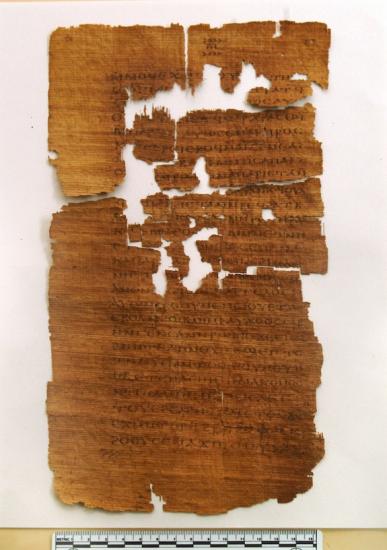American Chemical Society
Source - http://phys.org/news/2013-04-egyptian-certificate-key-authenticating-controversial.html#jCp

The Gospel of Judas, a text dated to about A.D. 280, tells the story of Judas as a collaborator with Jesus instead of a betrayer. CREDIT: Joseph Barabe, McCrone Associates, Inc
A scientist who helped verify authenticity of the fabled Gospel of Judas today revealed how an ancient Egyptian marriage certificate played a pivotal role in confirming the veracity of inks used in the controversial text. The disclosure, which sheds new light on the intensive scientific efforts to validate the gospel, was made here today at the 245th National Meeting & Exposition of the American Chemical Society (ACS).
"If we hadn't found a Louvre study of Egyptian wedding and land contracts, which were from the same time period and had ink similar to that used to record the Gospel of Judas, we would have had a much more difficult time discerning whether the gospel was authentic," said Joseph G. Barabe. A senior research microscopist at McCrone Associates, he led an analytical team of five scientists who worked on the project at McCrone, a consulting laboratory in microscopy and microanalysis in Westmont, Ill. "That study was the key piece of evidence that convinced us that the gospel ink was probably okay."
Barabe's team was part of a multidisciplinary effort organized in 2006 by the National Geographic Society to authenticate the Gospel of Judas, which was discovered in the late 1970s after having been hidden for nearly 1,700 years. The text, written in Egyptian Coptic, is compelling because—unlike other Biblical accounts that portray Judas Iscariot as a reviled traitor—it suggests that Jesus requested that his friend, Judas, betray him to authorities.
Barabe's presentation was part of an ACS symposium on archeological chemistry.
After analyzing a sample, Barabe and his colleagues concluded that the gospel was likely penned with an early form of iron gall ink that also included black carbon soot bound with a gum binder. While this finding suggested that the text may have been written in the third or fourth century A.D., the researchers were perplexed by one thing: The iron gall ink used in the gospel was different than anything they'd ever seen before. Typically, iron gall inks—at least those from the Middle Ages—were made from a concoction of iron sulfate and tannin acids, such as those extracted from oak gall nuts. But the iron gall ink used to produce the Gospel of Judas didn't contain any sulfur. And that, Barabe said, was troubling.
"We didn't understand it. It just didn't fit in with anything that we had ever encountered," he said. "It was one of the most anxiety-producing projects I've ever had. I would lie awake at night trying to figure it out. I was frantically searching for answers."
Ultimately, Barabe found a reference to a small French study conducted by scientists at the Louvre who analyzed Egyptian marriage and land records written in Coptic and Greek and dating from the first to third centuries A.D. Much to Barabe's relief, those researchers had determined that a wedding certificate and other documents were written in ink made with copper, but little or no sulfur.
"Finding that study, and realizing its implications, tilted my opinion a little in the direction of it being appropriate for the era," Barabe said. "My memory of that experience remains quite vivid. I had a sudden feeling of peace that things were okay, and that I could submit my data without qualms."
Barabe now suspects that the ink used in the Gospel of Judas was probably transitional, a "missing link" between the ancient world's carbon-based inks and the iron gall inks (made with iron sulfate) that became popular in medieval times.
More information: Abstract
Characterization of the ink on the Gospel of Judas: A collaborative approach
In 2006, the National Geographic Society (NGS) contracted with McCrone Associates to characterize the ink in a purportedly 3rd century document, the Gospel of Judas, in order to determine whether the ink was consistent with materials and manufacturing methods of 3rd century Egypt. McCrone's approach was to assemble a group of scientists with expertise in different aspects of microanalysis: The project required taking the initial ink samples in Geneva, Switzerland, specimen preparation for each of the instruments, and analysis by polarized light microscopy, scanning electron microscopy with high-resolution imaging and energy dispersive X-ray spectrometry (EDS), X-ray diffraction, transmission microscopy with EDS, and infrared and Raman spectroscopy. The ink turned out to be an unexpected mix of a traditional carbon black ink in a gum binder with an iron gall component which lacked the expected sulfur. Altogether, our findings are not inconsistent with 3rd century Egyptian ink.